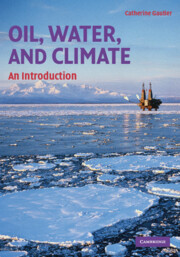Book contents
- Frontmatter
- Contents
- Foreword
- Introduction
- 1 Overview
- 2 Carbon Dioxide Emissions, Global Warming, and Water Resources
- 3 Population, Environmental Impacts, and Climate Change
- 4 Carbon Cycle and the Human Impact
- 5 Peak Oil, Energy, Water, and Climate
- 6 Oil Consumption and CO2 Emissions from Transportation
- 7 Oil, Economy, Power, and Conflicts
- 8 Energy Alternatives and Their Connection to Water and Climate
- 9 The Water Cycle and Global Warming
- 10 Fresh Water Availability, Sanitation Deficit, and Water Usage: Connection to Energy and Global Warming
- 11 Rivers, Lakes, Aquifers, and Dams: Relation to Energy and Climate
- 12 Water Contamination, Energy, and Climate
- 13 Geopolitics of Water and the International Situation
- 14 Water Alternatives
- 15 Global Climate Change: Observations, Modeling, and Predictions
- 16 Energy and Water Challenges and Solutions in a Changing Climate Framework: Commonality, Differences, and Connections
- References
- Index
12 - Water Contamination, Energy, and Climate
Published online by Cambridge University Press: 05 September 2012
- Frontmatter
- Contents
- Foreword
- Introduction
- 1 Overview
- 2 Carbon Dioxide Emissions, Global Warming, and Water Resources
- 3 Population, Environmental Impacts, and Climate Change
- 4 Carbon Cycle and the Human Impact
- 5 Peak Oil, Energy, Water, and Climate
- 6 Oil Consumption and CO2 Emissions from Transportation
- 7 Oil, Economy, Power, and Conflicts
- 8 Energy Alternatives and Their Connection to Water and Climate
- 9 The Water Cycle and Global Warming
- 10 Fresh Water Availability, Sanitation Deficit, and Water Usage: Connection to Energy and Global Warming
- 11 Rivers, Lakes, Aquifers, and Dams: Relation to Energy and Climate
- 12 Water Contamination, Energy, and Climate
- 13 Geopolitics of Water and the International Situation
- 14 Water Alternatives
- 15 Global Climate Change: Observations, Modeling, and Predictions
- 16 Energy and Water Challenges and Solutions in a Changing Climate Framework: Commonality, Differences, and Connections
- References
- Index
Summary
Pollution of rivers, aquifers, and groundwater results from human activities, in particular the production of energy and food. Various types of contamination (agricultural, industrial, and domestic) require management and treatment. Water pollution affects health, and changes in precipitation frequency and intensity may exacerbate pollution, particularly in coastal regions and in large urban developments.
Introduction
In many areas in both developed and developing countries, water supplies suffer from serious and long-lasting contamination. Urban sprawl, rapid population growth, agricultural use, and industrial contamination are some of the main emerging challenges that threaten the quality and availability of drinking water. Many contaminants exist, be they physical, chemical, or microbiological substances. One important contaminant is the residual salt left both by the evaporation of the water used for irrigation and by saltwater intrusion in overexploited aquifers in coastal regions. Other commonly detected contaminants are fertilizer and pesticide residues from agriculture that, in some areas, have percolated down to deep aquifers. Indeed, irrigation induces high levels of water contamination by salts, nitrates, and pesticides to the point where major water reserves can no longer be used for drinking without expensive treatment.
The development of huge (mega) cities is also accelerating the depletion of surface and groundwater resources and their contamination by various pollutants. Aging or inadequate water delivery systems and poor water treatment techniques may allow the dispersal of pathogens and the breeding of bacteria in the water they carry.
- Type
- Chapter
- Information
- Oil, Water, and ClimateAn Introduction, pp. 222 - 244Publisher: Cambridge University PressPrint publication year: 2008



